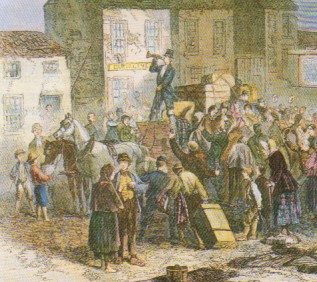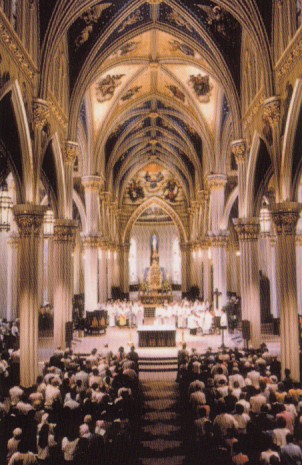|
● Religious
Liberty
● Protestants
in the United States
● CathoLics
● Three
Faiths
● Religious
Diversity
● American
Character of Religion
Catholics
 |
|
Crystal
Cathedral,LA(outside)
|
 Although
the largest church is of the Protestant faith, the largest single
religious group is that of Roman Catholics. More than one-quarter of all Americans
are now of the Roman Catholic faith. According to a survey done
in the early 1990s, Roman Catholics represent 26.2% of the U.S population(the
4 large Protestant groups, the Baptists, Methodists, Presbyterians,
Episcopalians
represent 31.9% of the population). The majority of the Catholics
are descendants
of immigrants from Ireland, Italy and Poland. Most of the early
Catholics stayed near the East Coast. They were concentrated especially
in New York and Massachusetts, and are still a very Although
the largest church is of the Protestant faith, the largest single
religious group is that of Roman Catholics. More than one-quarter of all Americans
are now of the Roman Catholic faith. According to a survey done
in the early 1990s, Roman Catholics represent 26.2% of the U.S population(the
4 large Protestant groups, the Baptists, Methodists, Presbyterians,
Episcopalians
represent 31.9% of the population). The majority of the Catholics
are descendants
of immigrants from Ireland, Italy and Poland. Most of the early
Catholics stayed near the East Coast. They were concentrated especially
in New York and Massachusetts, and are still a very
 |
|
Irish
Immigrants
|
important element of the population
in those two states. By the Civil War, over a million Irish Catholics,
many driven by hunger, had come to the United States. Most were
working people. Anti-Catholic prejudice was so strong that, on a
few occasions, it broke out in mob violence. In 1844, two Catholic
churches were burnt and 13 people died in rioting that swept through
the city of Philadelphia, Pennsylvania. More
often prejudice took the form of discrimination, particularly at
the polls.
By 1960, however, John F. Kennedy's presidential election victory
put to rest the catholic religion as an issue in national politics.
Kennedy was Roman Catholic. Catholics were not shut out of public
schools and hospitals but they wanted their own schools, colleges
and hospitals.Catholics believed that these institutions were needed
 |
|
Nortre
Dame University Church
|
to preserve their faith. Many Catholics
now attend public schools and secular
colleges. But Catholic institutions, especially in large cities,
still serve large numbers of Catholics and a growing number of non-Catholics,
who are attracted by the discipline and education offered in these
schools. By the 1950s, many Catholics had risen to positions of
leadership, not only in labor unions, but also in business and politics
as well. As
Catholics grew more confident about their place in American life,
they began to challenge, not the basic idea of separation of Church
and State, but the way American courts interpreted it.
The costs of modern education had made their schools very expensive
to maintain. Catholics began to seek some way in which they could
obtain public funds to help meet these expenses. Other private schools,
not necessarily religious in origin or concern, also sought this
help.
 The
lawmaking bodies of many states were sympathetic to these demands.
But most attempts to provide help for religious schools were ruled
unconstitutional
(declared to violate
the Constitution) by the Supreme Court of the United States. Giving
public money to a religious school was held to violate the clause,
or part of the First Amendment which prohibits the establishment
of religion. Public money for religious schools remains
an issue in American politics in the 1990s.If Catholics feel that
government should support the non-religious aspects of private education,
other American groups call for even less government connection to
religion. Sunday
closing laws were a real hardship to Jews. In
effect, they
were forced to observe
two
Sabbaths,
or
days of rest—their own and the majority Christian one as well.
Nonbelievers, and some religious people as well, objected to prayer
and Bible reading in public schools. They thought that a modern
government in a free society should be basically secular. The
lawmaking bodies of many states were sympathetic to these demands.
But most attempts to provide help for religious schools were ruled
unconstitutional
(declared to violate
the Constitution) by the Supreme Court of the United States. Giving
public money to a religious school was held to violate the clause,
or part of the First Amendment which prohibits the establishment
of religion. Public money for religious schools remains
an issue in American politics in the 1990s.If Catholics feel that
government should support the non-religious aspects of private education,
other American groups call for even less government connection to
religion. Sunday
closing laws were a real hardship to Jews. In
effect, they
were forced to observe
two
Sabbaths,
or
days of rest—their own and the majority Christian one as well.
Nonbelievers, and some religious people as well, objected to prayer
and Bible reading in public schools. They thought that a modern
government in a free society should be basically secular.
|

